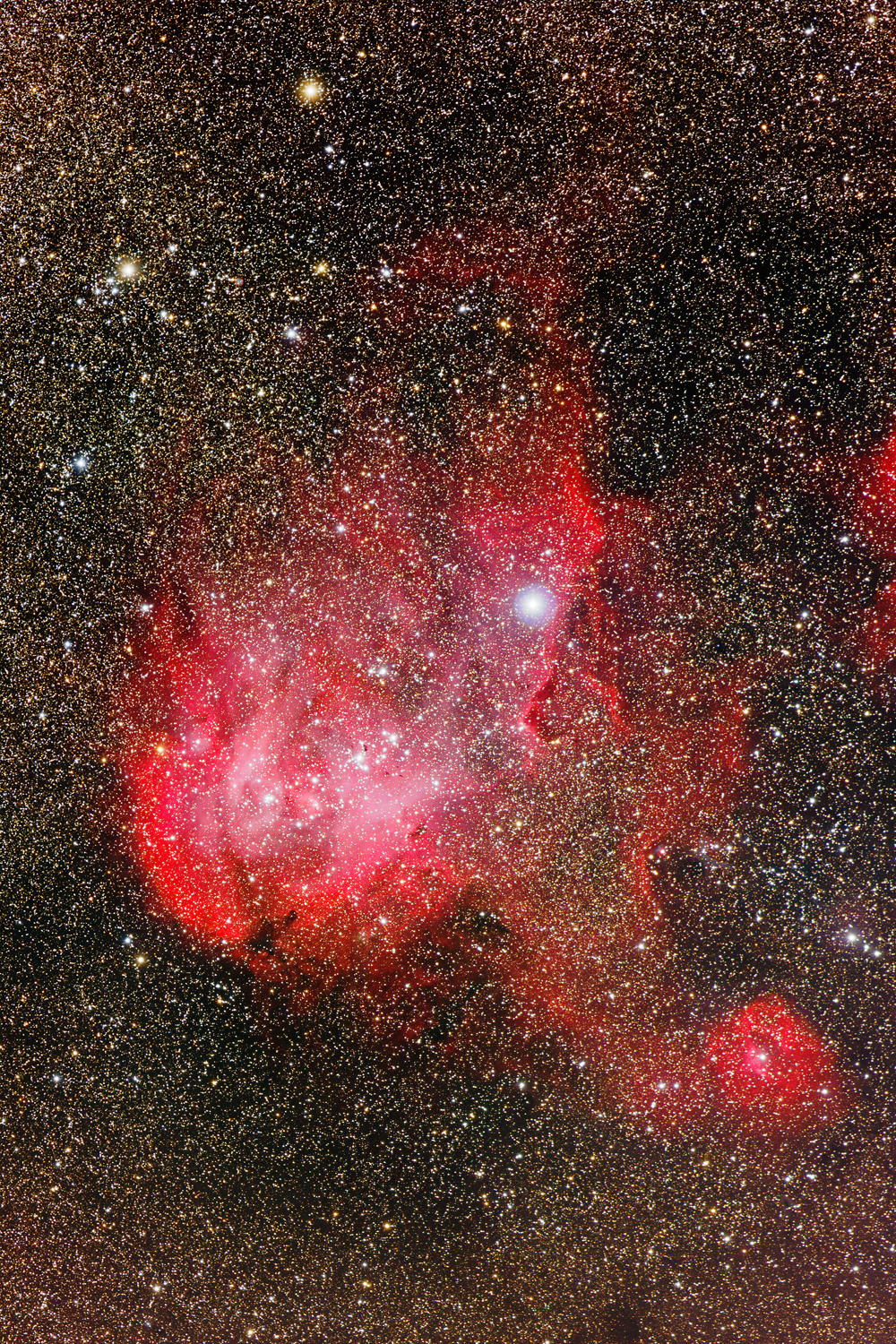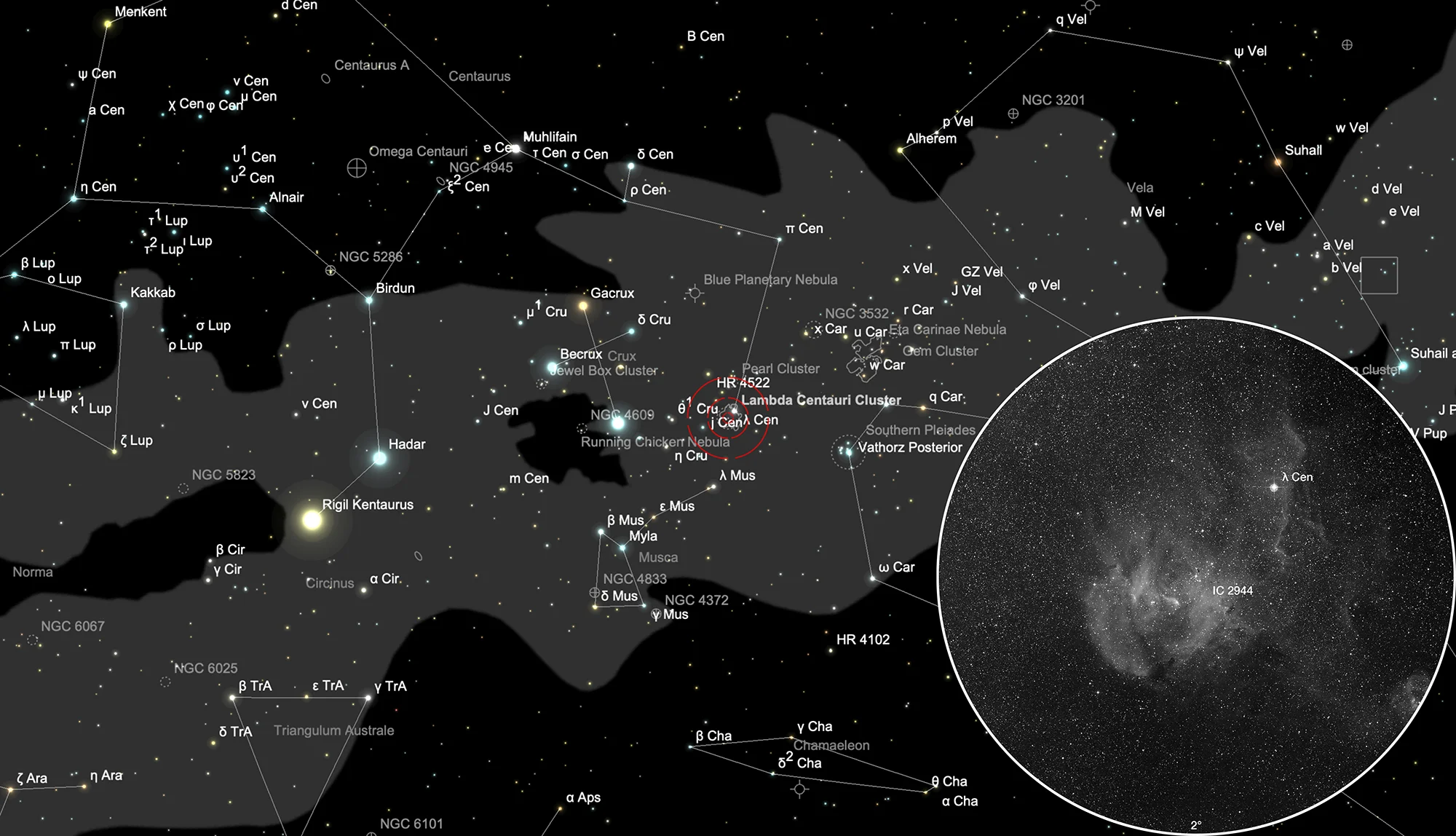Running Chicken Nebula, Lambda Centauri Nebula (IC 2944)


History
On 5 May 1904 the American astronomer Royal H. Frost discovered IC 2944 (F 789) along with IC 2948 (790), on a photographic plate taken with the the 24-inch f/5.6 Bruce photographic refractor Arequipa station in Peru. He noted nebulosity but missed the scattered cluster. The IC designations refer to different parts of the same HII complex. [364]
Based on a photograph taken with the Franklin-Adams camera in June 1910 at the Union Observatory in Johannesburg, H. E. Woods described «A very large nebulous region - irregular in shape, somewhat resembling a pear. The star Lambda Centauri is involved in the nebula at the narrow end of the of the pear. The stars CPD -62°, 2154, 2168, 2164, 2186, 2184, 2206 and 2142 are also surrounded by nebulosity. There are rifts through the nebula breaking it up into three main portions. The bright portion of the nebula covers about 40' in declination and 5 minutes in RA, but there are fainter extensions about 1° from the main body.» [364]
In 1931 Swedish astronomer Per Collinder published his «Catalogue of Open Galactic Clusters» based on a survey of Lundmark using the Franklin-Adams plates and Collinder using the Franklin-Adams charts. Cluster nr. 249 (Collinder 249, Cr 249) is listed there identified as IC 2944 with dimensions of circa 40×15 arcminutes and containing 25 stars. He added the notes: «This is a chain of bright stars with nebulosity. Areal density of fainter stars the same as in surroundings (from star-counts).» [455]
IC 2944 got the nickname «Running Chicken Nebula» from the bird-like shape of its brightest region. Another commonly used name is «Lambda Centauri Nebula».
Physical Properties

IC 2944 is a HII nebula, which means that the hydrogen gas is excited by the massive young stars in this cluster. These stars are much hotter and much more massive than our Sun and burn through their hydrogen deposit much faster. Additionally, it is a region with active star formation. Due to their high temperatures and large masses, these young stars strongly influence the surrounding matter by emitting radiation and stellar winds that promote the birth of new stars. The nebula contains numerous dense clouds of dust and gas, which serve as nurseries for new stars and highlight the dynamic nature of this region.
Dense, opaque dust clouds have been found within nebula. These globules, named after Astronomer A.D. Thackeray who first spied them 1950 in IC 2944 are generally associated with areas of star formation. As these globules are under fierce bombardment from the ultraviolet radiation from nearby hot young stars, they are both being eroded away and also fragmenting. It is likely that they will be destroyed before they can collapse and form new stars and planetary systems. [668, 669]
| Name | RA | Dec | Type | bMag | Dim | MD | Dreyer Description | Identification, Remarks |
|---|---|---|---|---|---|---|---|---|
| IC 2944 | 11 35 47.3 | -63 01 11 | EN | 4.5 | 40 × 20 | 2.000 | * 3.4 in eL neb | Running Chicken nebula |
| IC 2948 | 11 39 05.0 | -63 26 36 | EN | 45 × 40 | 2.000 | eeL | ESO 94-SC5 involved |
Finder Chart
The nebula IC 2944 is located in the constellation Centaurus near the 3.1 mag bright star λ Centauri. Unfortunately it is not visible from Europe. On 14 March it in opposition with the Sun and is therefore highest in the sky at local midnight.
